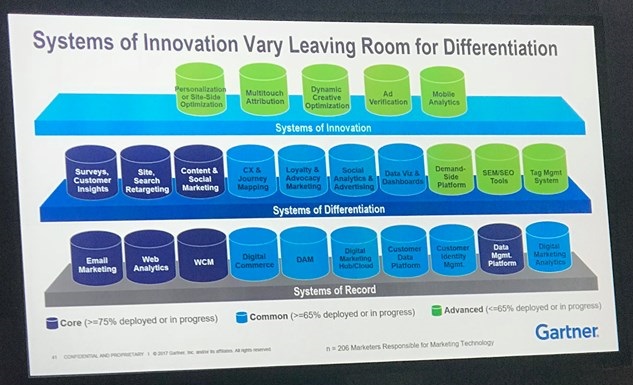Episerver Ascend 2018 Recap from the CMSC Perspective
Have you been to a conference lately that is just effortlessly educational and entertaining all at  once? So much so that its magnetic impact remained on your mind long after you’ve left? My coworker Laura Myers and I recently had this experience at Episerver Ascend 2018 in Las Vegas.
once? So much so that its magnetic impact remained on your mind long after you’ve left? My coworker Laura Myers and I recently had this experience at Episerver Ascend 2018 in Las Vegas.
Just like the previous years, at Episerver Ascend 2018, there was no shortage of inspirational keynotes, new announcements and well moderated interactive sessions, product demos, more than 80 breakouts, and networking events. There were also over 50 Episerver employees on hand.
As usual, the first day kicked off with Episerver’s CEO Mark Duffel’s keynote. In his keynote, Duffel shared some important data points on Episerver’s growth in recent years. Here are some of them from my notes:
-
Episerver saw 90% YOY growth in cloud subscription.
-
North America has surpassed the other regions in cloud subscription with 150%.
-
The Episerver team has expanded 50% in the past two years.
-
Lastly, thanks to its recent product launches, the vendor saw 100% growth in the product portfolio.
He stated on stage that Episerver will continue to instantly recognize its customers’ needs and empower them by making its products simple, dependable, and collaborative. He also briefly touched upon why the importance of security is growing and recognized Episerver’s most recent hire, Sue Bergamo, CIO and CISO.
After Duffel, James Norwood, CMO and EVP, strategy at Episerver, took over the stage with a very informative and personable presentation. It was “personable” because we all got to see a cute picture from his childhood back in 1969. It was an entertaining touch while he was talking about the digital transformation happening at light speed.
He also did a quick poll with the live audience by asking: “What is your primary purpose for visiting a brands website or mobile app for the first time?” The most popular answer was: “Searching for a product or service,” which is perfectly aligned with one of the main findings of a recent Episerver study. According to the study, more shoppers are going online to search for (35 percent) and compare (29 percent) products/services than they are to buy (17 percent) when visiting a brand’s site for the first time.
Modernizing the Brick-and-Mortar Business Model despite the Amazon Effect
Norwood also cited an IBM study and said: “72% of surveyed CxOs claimed that incumbent organizations – rather than new entrants – are leading the disruption in their industry. By comparison, only 22% say smaller companies and start-ups are leading disruptive change.” To me, this was a very eye-opening point. Frankly, I would never guess that there was a huge gap between incumbents and new entrants in terms of disruption.
With the state of incumbents’ disruption in mind, Norwood shared a very inspiring digital  transformation story of Eason, the largest supplier of books, magazines, and newspapers in Ireland.
transformation story of Eason, the largest supplier of books, magazines, and newspapers in Ireland.
Having been in the bookselling business for over 200 years, Eason is a well-established brand. However, due to the rapid Digital Transformation happening around the company and the industry, a few years ago, the brand quickly started getting swept away and came to the point where its online presence simply didn’t match the company’s offline brand identity. And, guess who else also started off as an online bookstore selling books? Yes, Amazon!
What the Eason team needed to do was to create an omnichannel experience enabling them to deliver as consistent and captivating a commerce experience online as they do offline. The implementation of Episerver resulted in a significant revenue uplift compared to 2016. The company saw 60% YOY revenue uplift during Black Friday and 75% in January sales.
As far as website performance and scalability go, the platform saw over 1000 unique visitors in under 20 minutes during the Late Late Toy Show, which typically takes place a few weeks before Christmas in Ireland.
Of course, these and many other great results didn’t happen just because they implemented the right platform. It sure took teamwork that involved every stakeholder. At the end of the day, to integrate Eason's brick and mortar success seamlessly with their digital landscape, the company invested around $15 million, according to Norwood.
The New Normal: Quality over Quantity
“Customer Experience (CX) is about customer journey, rather than conversion or purchases,” said Norwood. He then shared one piece of good news and one piece of bad news on that matter. Good news, a whopping number of c-suites are aware of the importance of CX, according to an IBM study. In fact, 68% emphasize CX over products. Bad news, delivering a great CX is not going to get easier, thanks in large part to the new regulations such as GDPR and security concerns.
Speaking of concerns, Norwood also touched upon an Episerver study that we also covered here early this week. Episerver surveyed 4,000 global consumers and found that a large majority (87 percent) of consumers are actually willing to give up their personal information to brands if it means a better online experience. However, over a third (35 percent) reported feeling that brands simply don’t care about personalizing their online shopping experience.
We also discussed this data point with Norwood in an exclusive CMS-Connected video interview filmed at the event. To watch the full interview, do not forget to check back to our website in the upcoming weeks.
Norwood ended his keynote by explaining why elevating the customer experience is correlated with organizations digital maturity. In today’s world, he suggested businesses that strive to thrive in customer experience:
-
Take a mobile-and-IoT-first approach
-
Think about the customer journey more in advance
-
Become customer obsessed
-
Deliver personalized and inspirational experiences
-
Gain an exclusive expertise
Takeaways from the Keynote by Kirsten Newbold-Knipp of Gartner
After Norwood, Kirsten Newbold-Knipp, Research Director, Gartner took over the stage and  shared interesting findings from a Gartner study that illustrates the shift from product-focused marketing to customer experience-driven marketing. She said: “By 2019, 81% of marketing leaders expect to compete almost completely on customer experience. 67% do so today and 60% did two years ago.”
shared interesting findings from a Gartner study that illustrates the shift from product-focused marketing to customer experience-driven marketing. She said: “By 2019, 81% of marketing leaders expect to compete almost completely on customer experience. 67% do so today and 60% did two years ago.”
Then, she talked about disruptive technologies such as VR/AR, conversational systems, smart houses, and online systems. Her presentation was also very personable as she shared her own story of building a new modern house. She beautifully told her story to put it into perspective that how those new technologies could be injected into a customer journey in innovative and practical ways.
As progressive as all those sound, as Norwood also mentioned in his keynote, the success of the integration between customer experience and technology depends on an organizations’ digital maturity. To that end, Newbold-Knipp, first, gave these fundamental steps and then, she delved into each:
It’s about the experience: She suggested not focusing on purchases, instead, focusing more on advocacy because the point is not only selling to customers but making them come back again and again.
Your Martech stack should reflect your customers’ journey: Although every business has different components of their customers’ journey, she explained this point by dividing a customer journey into three stages; buy, own, and advocate. Then, she shared the illustration below to give an example of how organizations can utilize systems differently at every stage of the journey.

Build it like a house, one step at a time: At this point, Newbold-Knipp shared a framework called pace-layering framework that has been used by Gartner to navigate the marketing and IT organizations. The framework consists of three layers; systems of record, systems of differentiation, and systems of innovation. In her presentation, she explained each layer but here is a capture of the slide demonstrating all three layers at once.

You can’t do it alone: Lastly, Newbold-Knipp drew attention to the importance of the effective collaboration between the IT and marketing teams. To tighten the relationship between cross-functional departments, she suggested having shared goals and joined roadmap.
My POV
The content of keynotes definitely exceeded my expectations. All the attendees left Vegas with pages and pages of disruptive ideas, best practices, information, and new peer connections besides great memories.
My co-worker Laura Myers sat down with the Epi executives and customers to video interview them at the event, including James Norwood, CMO and EVP, Strategy; Chad Wolf, Chief Customer Officer; Ed Kennedy, Head of Commerce; Sue Bergamo, CIO and CISO; Justin Anovick, VP Product; Troy Hunt, Microsoft MVP, Tony Ellis, Head of IT for Toppers Pizza; Mike Seminara, Head of Marketing for Janome; Steve Loud, Digital Commerce Director for D'Addario; and Marcus Jones, Director of Global Digital Strategy for Mazda Motor Corporation. To binge on all of our exclusive content from the event, please check back to our website in the upcoming days.
Before I go, I’d like to give a special shoutout to the Ascend team as they were extremely helpful and energetic throughout the event. If you couldn’t make it this year, make sure to be part of the Ascend 2019 as I have no doubts that you will learn so much.

Venus Tamturk
Venus is the Media Reporter for CMS-Connected, with one of her tasks to write thorough articles by creating the most up-to-date and engaging content using B2B digital marketing. She enjoys increasing brand equity and conversion through the strategic use of social media channels and integrated media marketing plans.